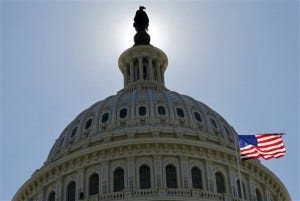What’s the Deal with the Debt?
What’s the deal with the debt deal? There still isn’t one yet. With the biggest sticking point now, how long to extend the credit limit of the US.
FOX News Radio’s Jared Halpern is following the story on Capitol Hill:
Congressman Clyburn is the Assistant Democratic Leader in the House.
Lawmakers have until August 2nd to raise the debt limit… and if it is not raised by then – the US risks defaulting on it’s debts… something that the Obama administration has warned could trigger economic catastrophe.
House Speaker John Boehner released this statement & outline of the debt plan being put forward by House Republicans:
“Republicans have put forward a responsible, common-sense proposal that meets our obligations to the American people and preserves the full faith and credit of the United States. This plan is far from perfect, but it adheres to our principles of ensuring that spending cuts are greater than any debt hike and it includes no tax increases. Importantly, it reflects the principles of ‘Cut, Cap, and Balance.’
“Time is running short and it would be irresponsible for the President to veto this common-sense plan and run the risk of default. I would encourage the Senate to pass this plan and the President to sign it.”
OUTLINE: This two-step approach outlined by GOP leaders today will (1) make spending cuts that are larger than any debt ceiling increase; (2) implement spending caps to restrain future spending; and (3) advance the cause of the Balanced Budget Amendment – without tax hikes on families and job creators. Here is more information on the plan:
- Cuts That Exceed The Debt Hike. The framework would cut and cap discretionary spending immediately, saving $1.2 trillion over 10 years (subject to CBO confirmation), and raise the debt ceiling by less – up to $1 trillion.
- Caps To Control Future Spending. The framework imposes caps on discretionary spending that would establish clear limits on future spending and serve as a barrier against government expansion while the economy grows. Failure to remain below these caps will trigger automatic across-the-board cuts (otherwise known as sequestration).
- Balanced Budget Amendment. The framework advances the cause of the Balanced Budget Amendment by requiring the House and Senate to vote on the measure after October 1, 2011 but before the end of the year, allowing the American people time to build sufficient support for this popular reform.
- Entitlement Reforms & Savings. The framework creates a Joint Committee of Congress that is required to report legislation that would produce a proposal to reduce the deficit by at least $1.8 trillion over 10 years. Each Chamber would consider the proposal of the Joint Committee on an up-or-down basis without any amendments. If the proposal is enacted, then the President would be authorized to request a debt limit increase of $1.6 trillion.
- No Tax Hikes. The framework includes no tax hikes, a key principle that Republicans have been fighting for since day one.








